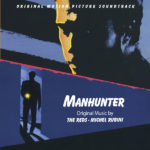
Three interviews . . .
Rick Shaffer & Raphaël Tchelebi, Trackzone, Paris, France

Following the CD release of Manhunter by Intrada Records, we contacted The Reds through their official website to do an interview. Rick Shaffer, the band’s guitarist, answered our questions. Raphaël Tchelebi, 10 Avril 2010, Paris, France
■ First of all, could you tell us how The Reds were formed?
I formed The Reds in 1977, along with Bruce Cohen. The idea was to create a sound, not preconceived, and to incorporate my metallic guitar style, combined with Bruce’s electronic atmospheric keyboards and treatments. And, I’ve tried to create a vocal and lyrical style that is distinctive, so when listeners hear a song they automatically know it’s The Reds.
■ How would you define your musical universe?
Our musical universe is derived from being influenced by all the fantastic blues artists, and 1960’s garage bands, combined with the experimental and atmospheric work of Can, Brian Eno, and the percussive fusions and tonality of the great Miles Davis. And, of course, we continue to explore the possibilities through current innovative artists, especially like Massive Attack, Aphex Twin, Portishead, and Klaus Wiese.
■ When we have a look at your work, we see several soundtracks for cinema and television. One of them is the long-awaited release on CD of Manhunter. How did you arrive on this particular project?
Our manager submitted our songs to Michael Mann for Miami Vice, and he started to use our material in episodes of the show. Then, while we were on tour, I was reading the Thomas Harris novel, “Red Dragon.” When we heard Mann was going to direct a film based on the book, we asked if we could contribute some material. However, he first wanted us to write songs and score for Band of The Hand, which he was producing, and Paul Michael Glaser was directing. During the same time period, Mann completed shooting Manhunter, was just starting post-production, and he asked us to write the Manhunter score, which we did over a two-month period in New York, and Los Angeles.
■ What were Michael Mann’s instructions for the score and how did you approach the movie in terms of instrumentation, mood, motifs . . .?
The first thing you must understand is that Michael Mann is a great artist, and is extremely detail oriented. He has a tremendous knowledge of all music genres. So, he was able to be very specific in suggesting what he wants. For instance, he’d mention a song like, “I Had Too Much To Dream Last Night,” by the Electric Prunes, and talk about specific sounds of the production. So, Mann’s instructions were always very clear and specific. Another example is the Leed’s House direction incorporated discussions of metallic guitars and keyboards, tremolo, and distortion. Always with the direction to maintain the feeling of the scene, the colors, the lighting, the characters, especially Dollarhyde. So, Bruce and I would watch Dollarhyde’s scenes closely, and draw inspiration from what his character was all about. But, even with all of Mann’s input, he still allowed Bruce and I to have a tremendous amount of freedom to write what we thought fit a scene.
■ At the time of the film’s release, only two of your contributions were included on the soundtrack album. For the CD, Intrada has secured one more track (“Jogger’s Stakeout”). Was it difficult, or even impossible to have more music of yours on this new edition?
Our manager had been trying for years to get the soundtrack re-released because of the many requests Tarock Music would get from fans all over the world. In 2009 she contacted Intrada Records with the CD idea. Then, once they agreed, she told them Manhunter fans especially asked about Jogger’s Stakeout, and it would be a good idea to add the song. Intrada agreed and got permission from Universal to add the extra song.
■ Could you tell us how much material you wrote, and if you had anything to say about the music included on the LP, then on the actual CD release?
The actual score in the film is twenty-eight minutes. There were a great deal of other cues written, however, either the piece was not used, or a piece was used in a scene, but then the scene was edited out. For example, at the Jacobi house, we wrote a lot of music for those scenes, but then Mann decided to use Shriekback, which we agreed worked better. Michel Rubini contributed two cues, that totalled about six minutes. Graham’s Theme, if I remember correctly, was a request Mann made to Michel that he model it on Pink Floyd’s, Comfortably Numb.
We had no say about what would be on the original LP and, as mentioned, our manager’s input got Jogger’s Stakeout added to the CD, because she felt it would be an added bonus for the fans. We would have liked The Reds other ambient compositions, along with Kitaro and Klaus Schulze, to be included on the original LP too, but the decision was not ours.
■ You were two (Bruce Cohen and you) to create the music for Manhunter, and all the film you have contributed to. Could you describe your “4-hands” composition process?
The first thing we do is read the book, and/or screenplay, then we start composing using the rhythm, emotion, and atmosphere of the actual scene. Then we start to build different levels of texture, through atmospherics and percussion. The final touch is with electronic treatments on guitar and keyboards. We prefer to work right with the film, but a lot of directors just want us to give them a piece of music, so they can decide where/how it will be used.
■ Did you make any difference in working on a personal studio album and scoring a picture? For you, what is the particular interest of film music?
For The Reds albums, Bruce and I get ideas, together and separately, that we then develop together. The difference between the two is that the song drives what the sound of it will be, and the film music is driven by its theme, and what’s happening in a scene, as I mentioned earlier.
Our great interest in film composing is the combination of sound and vision. Film has a more immortal quality.
■ Finally, what are your upcoming projects, and you can add anything you want to say about Manhunter, film music, music in general, cinema . . .?
Bruce and I have just recently started to work separately, although at the beginning of 2011 we may start working on a new Reds album. Bruce’s first solo album, One BC, was released August 2009, and it contains all atmospheric ambient instrumentals in the tradition and style of Brian Eno, and Peter Gabriel. Then, in a totally different genre side project, Bruce put together a heavy, psychedelic, Hammond organ jazz trio called Big Fun 3. His Miami based group just signed with Ropeadope Records, with an album scheduled for release at the end of April (2010).
My first solo album, Necessary Illusion, will be released later this month (March 2010). It’s sonic signature is raw, distorted guitars, atmospheric percussion, stark droning hill country blues, in a swirl of “Excello Records” style reverb.
The Manhunter film, and working with Michael Mann, was a really great experience, because he gave us a different perspective of approaching music in both composition and mixing. His unbelievable work ethic is infectious, and rewarding.
Bruce and I have a great passion for film noir, indie, and foreign films, so we always enjoy working on all types of projects.
Thanks, Raphaël, it was a pleasure talking with you.
■ Special thanks to Rick, and Theresa Marchione, the band’s manager, for arranging this interview.